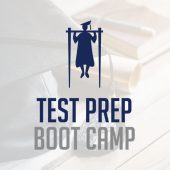ACT sure started this week with a bang. Three big announcements in one press release. 
“Hey, we’re going to let students take individual sections!”
Bam!
“And, you now have the option of online or paper tests at every national testing day!”
Bam!
“But wait, there’s more. We’ll even report a superscore for you!”
Mic drop.
In the excitement of how wonderful the ACT was being for students, a couple of points got glossed over, and they’re particularly problematic.
Not just yet . . .
These changes don’t go into effect until September of 2020. This probably won’t solve a problem for the class of 2021. It might be they can take advantage of this for the September or October ACT next year. For future classes, students will only be able to do section-only testing if they’ve already completed a full test, but section-specific testing brings up a second, probably bigger problem.
Online Only
The section-specific testing will only be available for the online version of the tests. And the online versions of the tests aren’t actually available everywhere. When ACT says, “Students will . . . have the option of online or paper testing on national test days at ACT test centers,” they leave out the fact that online testing is incredibly limited at the moment. In marketing speak, they say it’s at “selected centers initially, eventually expanding to all.” By “selected” they mean the incredibly few testing sites that offer online testing as an option.
Public schools, the primary locations for testing centers, aren’t equipped to offer hundreds of online tests to students. And ACT isn’t in a position to mandate that they do. They might have computer labs, but the recent push has been to more mobile laptop stations that can go to students. ACT isn’t going to be able to insist that schools use unsecure laptops given to students who may or may not be students at the school.
I’m pretty sure ACT knows this is going to be a problem. To confirm it, I had to click to 3 webpages passed their press release that got all the hype and then scroll down to the 6th item in their FAQs.

But wait, it’s bigger than that
The policy still doesn’t address an even bigger problem. When students do the online test, they lose out on a paper and pencil option. Everything is on a screen.
I can hear it now: “But Shane, it’s a digital age.”
The current experience has been that students do significantly worse on the online tests than they do on the paper version. It makes sense. They don’t get many opportunities to practice the online version. They’re used to being able to flip back and forth through the pages. In addition, the mechanics of the online version, especially for Math, make taking the test slower, and slower means lower scores.
Unintended consequences
This decision is going to have a number of unintended consequences. The biggest is that it plays to the advantage of an already advantaged group. We hear plenty about how affluent students have a much greater advantage on the tests. Which students do they think are going to take single-section tests? Students who are working with IEC’s or test prep professionals to guide them.
What might be worse is the school administrator who thinks this solves a problem. Ironically, the key to getting higher scores isn’t having more students take the tests. But a well-intentioned principal might see as a good thing for “stakeholders.” Online testing. What could be more 21st century learning?
So the principal brings in the entire school to take the test on a school-day option. (The press release is about national tests, but the same logic applies.) Now every student takes the test. The students who don’t see it as important for them do what teenagers do when they don’t think something is important to them. And the high performing students who could do especially well do 3-5 points worse than they probably would have done on a paper and pencil test.
ACT has a habit of creating press releases that are much more marketing than substance. Okay, all companies do that, and that is exactly what this is. These are adjustments, and they’re adjustments that students will appreciate, but they won’t actually solve a problem.






